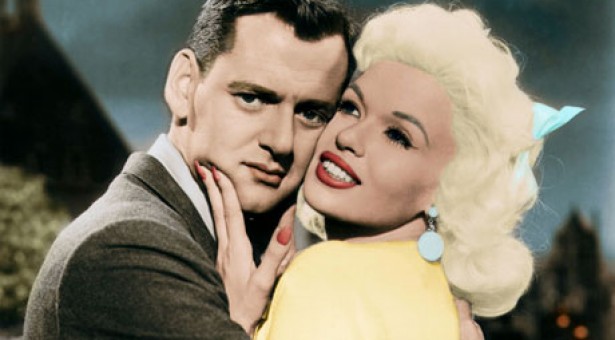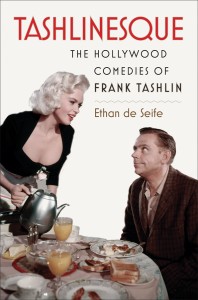Ethan De Seife: Tashlinesque

Česká verze recenze je dostupná zde / Czech version of the review is available here
If I were asked to compile a list of the most underappreciated Hollywood directors of all time, Frank Tashlin would figure prominently on such a list. Born in New Jersey, Tashlin made a long and rich career in entertainment, making his living as an illustrator, author of children’s books, supervisor of animated cartoons for Warner Bros. and Screen Gems, scriptwriter and gagman and eventually also as a director of successful feature films. He collaborated repeatedly with Bob Hope, Jerry Lewis (with whom he produced eight comedies in the late 1950s and early 1960s), Doris Day, Jayne Mansfield and Tony Randall among others. His comedies – and Tashlin rarely stepped out of this popular genre – were celebrated by French critics writing for Cahiers du Cinéma in the 1950s, especially by Jean-Luc Godard, and influenced numerous filmmakers such as Pedro Almodóvar and Joe Dante (for example Gremlins, The ‚Burbs, Looney Tunes: Back in Action). The literature on Tashlin, however, has been sparse and fragmented and a person potentially interested in reading about the director’s work had to do only with several essays and articles. Up to this spring, that is, when Ethan De Seife, researcher and associate professor at Hofstra University, New York, published a book-length study of Tashlin called Tashlinesque – The Hollywood Comedies of Frank Tashlin.1
In his book De Seife deals with Tashlin’s complete directorial oeuvre – from his beginnings at Warner Bros. (animated shorts with Bugs Bunny and Porky Pig) and Columbia and his first feature films, the best of which is probably Son of Paleface (1952) starring Bob Hope, to his more mature and accomplished collaborations with Jerry Lewis and Jayne Mansfield (The Girl Can’t Help It and Will Success Spoil Rock Hunter?) and finally to his ever interesting, even though less influential work from the late 1960s when Tashlin had to rely on less charismatic comedians such as Tony Randall. The author singles out characteristic features of Tashlin’s comedies, the most important of which are „sexual humor“, visual and acoustic gags, high level of self-reflexivity and frequent disruptions of the diegesis, reliance on mise-en-scene (props, acting) rather than editing, and use of the so-called non-gags, situations which are usually more elaborate and clever than straightforwardly funny (as in many films directed by Jacques Tati). Unfortunately, De Seife excludes from his discussion Tashlin’s work as a screenplay writer; however, he justifies his decision by saying that it’s almost impossible to demarcate the authorial line between writer and director in films such as The Paleface (1948, dir. Norman Z. McLeod) and The Good Humor Man (1950, dir. Lloyd Bacon) and thus „it seems more sensible simply to acknowledge that he /= Tashlin/ probably learned a great deal about comedy screenwriting during these five years, and to leave it at that.“
Naturally, the comedies of Frank Tashlin are not studied and discussed in isolation. On the contrary, De Seife constantly refers to relevant contexts and thus tackles broader issues and topics such as genre (comedy above all), authorship, relationship between animated shorts, live-action features and vaudeville and influence of Hollywood self-censorship practices on the finished films.2 The result is a multidimensional portrait not only of the filmmaker himself, but also of the American film industry of the 1940s-1960s. The last chapter, then, focuses on Tashlin’s influence on the work of his admirers, namely Jean-Luc Godard,3 Joe Dante and, to a lesser extent, Pedro Almodóvar.
There’s not much to criticize about the book, really. De Seife presents the reader with a logically structured and lucidly written text which constantly demonstrates author’s erudition and enthusiasm for the subject. Without a single doubt it counts among the best „directorial monographs“ I’ve read recently. The text is complemented by many illustrations, a detailed filmography and an index. And if you crave for more Tashliniana, you should visit De Seife’s well-maintained blog.
Useful links
– Ethan De Seife’s blog (Tashlin-related blog entries can be accessed here)
– interview with Ethan De Seife
– several of Tashlin’s early animated shorts can be viewed on YouTube
– video of director John Waters discussing The Girl Can’t Help It
– essay on Tashlin published by Senses of Cinema (written by none other than Ethan De Seife)
– Will Success Spoil Rock Hunter? was released on Blu-ray this winter as part of Masters of Cinema series; the disc can be purchased here
Tashlinesque – The Hollywood Comedies of Frank Tashlin
Ethan De Seife
Middletown, Wesleyan University Press
2012, 272 pages
the book can be purchased here
- the book was adapted from De Seife’s dissertation that was completed at the University of Wisconsin-Madison in 2005. [↩]
- for these purposes De Seife conducted an extensive research in the archives of Margaret Herrick Library in Beverly Hills. [↩]
- see for example his review of Hollywood or Bust; in Czech translation available as GODARD, Jean-Luc. Hollywood nebo smrt. In Jean-Luc Godard. Texty a rozhovory. Jihlava : JSAF, 2005. s. 67-69. [↩]







